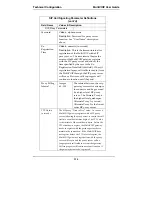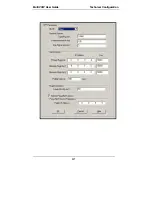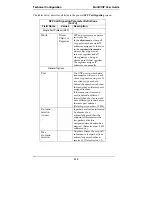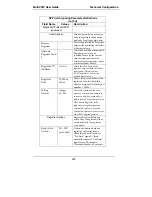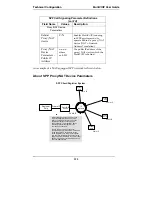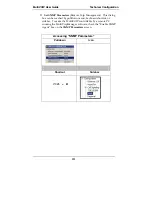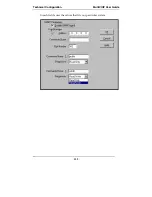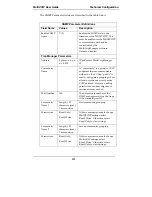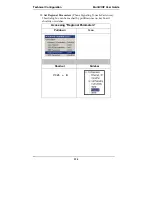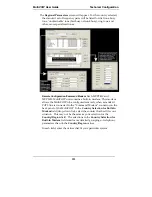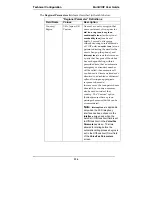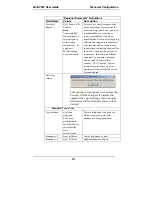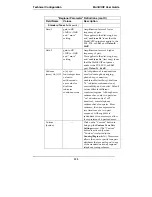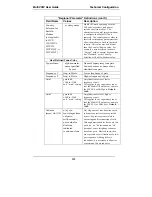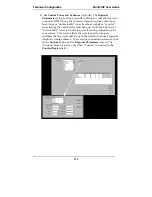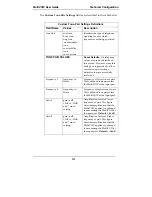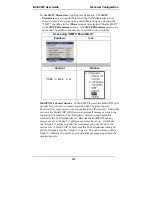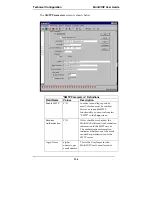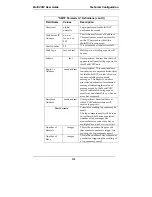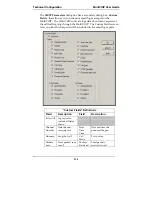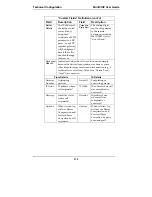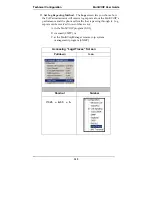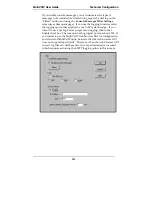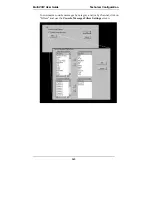
MultiVOIP User Guide
Technical Configuration
129
“Regional Parameter” Definitions (cont’d)
Field Name
Values
Description
Country
Selection for
Built-In
Modem
(
not applicable
to MVP-
130/130FXS
MVP210,
MVP410ST, or
MVP810ST
)
country name
MultiVOIP units operating with the
X.06 software release (and above)
include a built-in modem. The
administrator can dial into this modem
to configure the MultiVOIP unit
remotely. The country name values in
this field set telephony parameters that
allow the modem to work in the listed
country. This value may be different
than the Country/Region value. For
example, a user may need to choose
“Europe” as the Country/Region value
but “Denmark” as the Country-
Selection-for-Built-In-Modem value.
User Defined Tones
fields
Type column
alphanumeric
name specified
by user
Name of supervisory tone pair.
Cannot be same as name of any
standard tone pair.
Frequency 1
freq. in Hertz
Lower frequency of pair.
Frequency 2
freq. in Hertz
Higher frequency of pair.
Gain 1
gain in dB
+3dB to –31dB
and “mute” setting
Amplification factor of lower
frequency of pair.
This applies to any supervisory tones
that the MultiVOIP outputs as audio to
the FXS, FXS, or E&M port.
Default:
-
16dB
Gain 2
gain in dB
+3dB to –31dB
and “mute” setting
Amplification factor of higher
frequency of pair.
This applies to any supervisory tones
that the MultiVOIP outputs as audio to
the FXS, FXO, or E&M port.
Default: -
16dB
Cadence
(msec) On/Off
n/n/n/n
four integer time
values in
milli-seconds;
zero value for
dial-tone
indicates
continuous tone
On/off pattern of tone durations used
to denote supervisory tones specified
by user. Supervisory tones relate to
answering and disconnection of calls.
Although most cadences have only two
parts (an “on” duration and an “off”
duration), some telephony cadences
have four parts. Most cadences, then,
are expressed as two iterations of a two-
part sequence. Although this is
redundant, it is necessary to allow for
expression of 4-part cadences.
Summary of Contents for MULTIVOIP MVP-3010
Page 6: ...6 Chapter 1 Overview ...
Page 28: ...28 Chapter 2 Quick Start Instructions ...
Page 38: ...Technical Configuration T1 E1 MultiVOIP User Guide 38 Chapter 4 Software Installation ...
Page 49: ...49 Chapter 5 Technical Configuration ...
Page 58: ...Technical Configuration MultiVOIP User Guide 58 Config Info CheckList ...
Page 117: ...MultiVOIP User Guide Technical Configuration 117 ...
Page 139: ...MultiVOIP User Guide Technical Configuration 139 ...
Page 170: ...170 Chapter 6 T1 Phonebook Configuration North American Telephony Standards ...
Page 184: ...T1 Phonebook Configuration MultiVOIP User Guide 184 3 Select Inbound PhoneBook List Entries ...
Page 208: ...208 Chapter 7 E1 Phonebook Configuration European Telephony Standards ...
Page 252: ...252 Chapter 8 Operation and Maintenance ...
Page 257: ...MultiVOIP User Guide Operation Maintenance 257 The Call Progress Details Screen ...
Page 265: ...MultiVOIP User Guide Operation Maintenance 265 The Logs Screen ...
Page 277: ...MultiVOIP User Guide Operation Maintenance 277 ...
Page 280: ...Operation and Maintenance MultiVOIP User Guide 280 T1 Statistics Screen ...
Page 288: ...Operation and Maintenance MultiVOIP User Guide 288 ...
Page 343: ...343 Chapter 9 Warranty Service and Tech Support ...
Page 347: ...347 Chapter 10 Regulatory Information ...
Page 352: ...352 Appendix A Cable Pinouts ...
Page 358: ...358 Appendix B TCP UDP Port Assignments ...
Page 360: ...360 Appendix C Installation Instructions for MVP428 Upgrade Card ...
Page 365: ...MultiVOIP User Guide Index 365 Index ...
Page 395: ...395 S000384A ...


